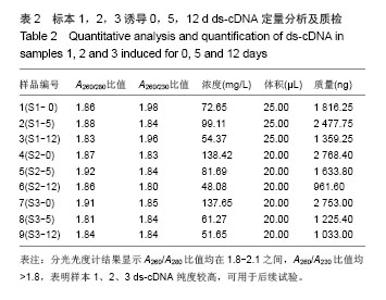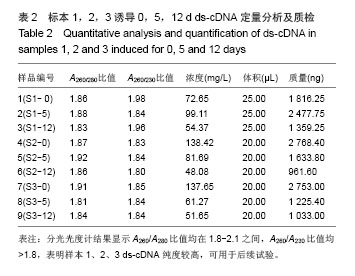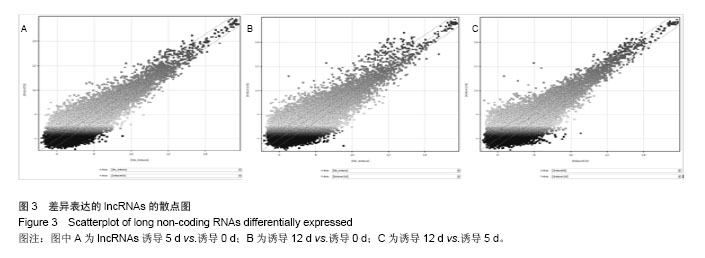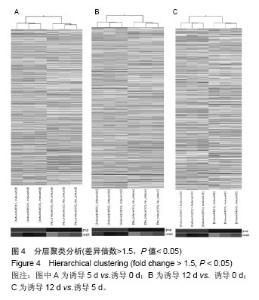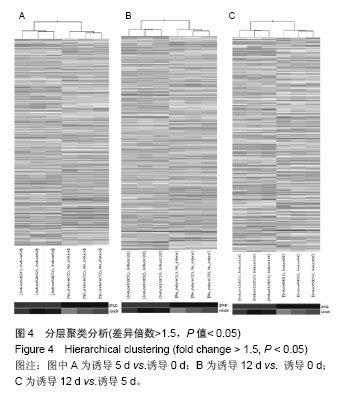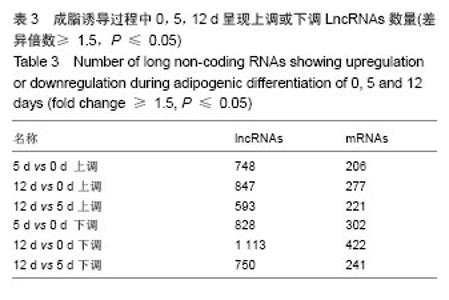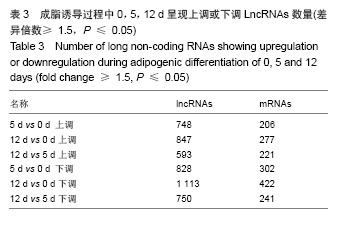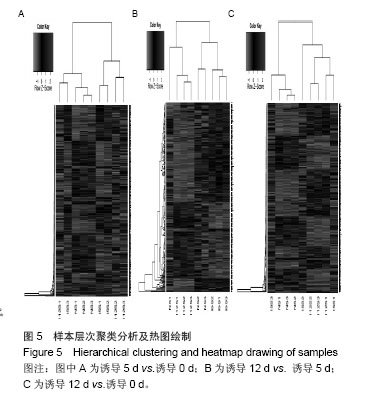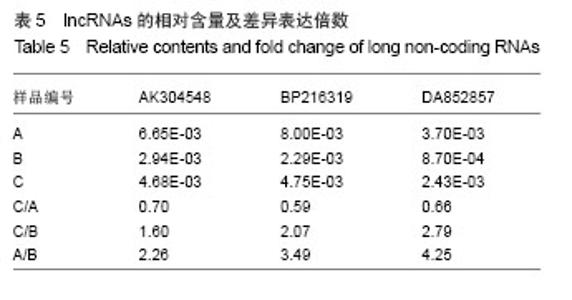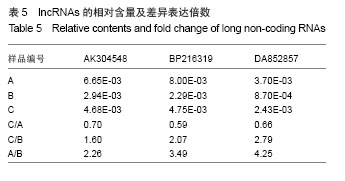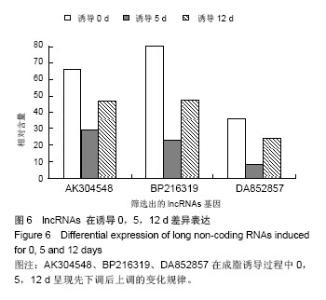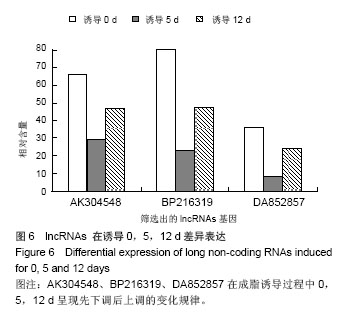Chinese Journal of Tissue Engineering Research ›› 2014, Vol. 18 ›› Issue (28): 4491-4497.doi: 10.3969/j.issn.2095-4344.2014.28.011
Previous Articles Next Articles
Differentially expressed long non-coding RNAs in adipogenic differentiation of human adipose-derived stem cells
Yue Wen-jun, Wang Xiang-mei, Zhang Qin, Huang Hai-hua, Wei You-wan, Peng Zhi
- Affiliated Hospital of Guangdong Medical University, Zhanjiang 524000, Guangdong Province, China
-
Online:2014-07-02Published:2014-07-02 -
Contact:Peng Zhi, Chief physician, Master’s supervisor, Affiliated Hospital of Guangdong Medical University, Zhanjiang 524000, Guangdong Province, China -
About author:Yue Wen-jun, Studying for master’s degree, Affiliated Hospital of Guangdong Medical University, Zhanjiang 524000, Guangdong Province, China -
Supported by:the Foster-Type Technological Innovation Team Project of Guangdong Medical University, No. TD1123
CLC Number:
Cite this article
Yue Wen-jun, Wang Xiang-mei, Zhang Qin, Huang Hai-hua, Wei You-wan, Peng Zhi. Differentially expressed long non-coding RNAs in adipogenic differentiation of human adipose-derived stem cells[J]. Chinese Journal of Tissue Engineering Research, 2014, 18(28): 4491-4497.
share this article
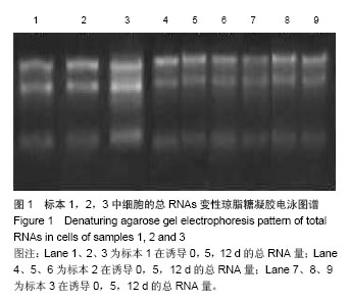
2.1 体外培养人脂肪来源干细胞生物学特性、成脂肪诱导分化 人脂肪来源干细胞原代培养细胞形态、流式细胞仪检测鉴定脂肪干细胞表型、成脂诱导分化0,5,12 d细胞形态及生长曲线参见已发表文章[11]。 2.2 RNA质量检测 lncRNAs及mRNAs的总RNA采用Trizol法提取,紫外分光光度计定量,根据RNA在A260/A280值1.80-2.10之间、A260/A230≥ 1.8。变性琼脂糖凝胶电泳28S、18S RNA条带比值≥ 1.5,鉴定RNA纯度及其完整性。结果显示各RNA样品A260/A280比值均位于2.0左右,A260/A230 > 2.0;RNA样品电泳条带清晰,28S与18S相比,RNA条带亮度接近2∶1,RNA完好无降解,质量符合lncRNAs微阵列的质量要求(图1,表2)。"
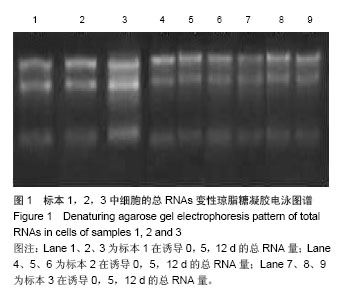
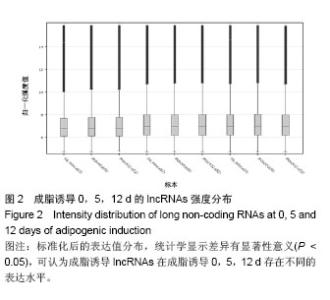
2.3 原始数据标准化、过滤及lncRNAs数据质量评估 2.3.1 lncRNAs数据质量评估 直方图(Box Plot)可方便快捷看出数据组的分布,广泛应用于比较样本之间的强度分布,图2表示来自于是3个标本的9个脂肪干细胞样本成脂诱导0,5,12 d lncRNAs标准化后的表达值分布(统计学P < 0.05,差异有显著性意义,可认为成脂诱导lncRNAs在成脂诱导0,5,12 d存在不同的表达水平)(图2)。 2.3.2 lncRNAs标准化后表达谱扫描筛选 散点图(Scatter Plot)可应用于评估芯片之间的变异度,图3是3个脂肪干细胞标本分成3组(诱导0,5,12 d),共9个细胞样本,进行样本两两之间比较的扫描结果,X轴表示控制数据值,Y轴表示表达值。最上面的直线以外的散点为上调2倍以上的差异基因表达谱;最下面的直线以外的散点为下调2倍以上的差异基因表达谱。离直线越远,表达的倍数越高。"
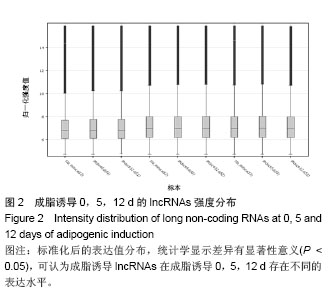
| [1]Kajimoto K, Naraba H, Iwai N.MicroRNA and 3T3-L1 pre-adipocyte differentiation.RNA. 2006;12(9):1626-1632.
[2]Esau C, Kang X, Peralta E,et al.MicroRNA-143 regulates adipocyte differentiation.J Biol Chem. 2004;279(50): 52361-52365.
[3]Lin Q, Gao Z, Alarcon RM,et al. A role of miR-27 in the regulation of adipogenesis.FEBS J. 2009;276(8):2348-2358.
[4]Cheung O, Puri P, Eicken C, et al. Nonalcoholic steatohepatitis is associated with altered hepatic MicroRNA expression.Hepatology. 2008;48(6):1810-1820.
[5]Lagos-Quintana M, Rauhut R, Yalcin A,et al. Identification of tissue-specific microRNAs from mouse.Curr Biol. 2002;12(9): 735-739.
[6]Xie H, Sun L, Lodish HF.Targeting microRNAs in obesity. Expert Opin Ther Targets. 2009;13(10):1227-1238.
[7]Hilton C, Neville MJ, Karpe F.MicroRNAs in adipose tissue: their role in adipogenesis and obesity.Int J Obes (Lond). 2013; 37(3):325-332.
[8]Heneghan HM, Miller N, Kerin MJ. Role of microRNAs in obesity and the metabolic syndrome.Obes Rev. 2010;11(5): 354-361.
[9]Kajimoto K, Naraba H, Iwai N. MicroRNA and 3T3-L1 pre-adipocyte differentiation.RNA. 2006;12(9):1626-1632.
[10]Sun L, Goff LA, Trapnell C,et al. Long noncoding RNAs regulate adipogenesis.Proc Natl Acad Sci U S A. 2013;110(9): 3387-3392.
[11]彭智,陈崎,贾振华,等.组织块培养法扩增人脂肪源性干细胞的生物学特征鉴定[J].中国组织工程研究与临床康复,2010,14(36): 6689-6694.
[12]Mercer TR, Dinger ME, Mattick JS. Long non-coding RNAs: insights into functions.Nat Rev Genet. 2009;10(3):155-159.
[13]Kung JT, Colognori D, Lee JT.Long noncoding RNAs: past, present, and future.Genetics. 2013;193(3):651-669.
[14]Wang KC, Chang HY.Molecular mechanisms of long noncoding RNAs.Mol Cell. 2011;43(6):904-914.
[15]Derrien T, Guigó R, Johnson R.The Long Non-Coding RNAs: A New (P)layer in the "Dark Matter".Front Genet. 2012;2:107.
[16]Finucane KA, McFadden TB, Bond JP,et al.Onset of lactation in the bovine mammary gland: gene expression profiling indicates a strong inhibition of gene expression in cell proliferation.Funct Integr Genomics. 2008;8(3):251-264.
[17]吕玉龙.基于双聚类的基因表达芯片分析[D].上海:上海大学, 2009.
[18]Da Sacco L, Baldassarre A, Masotti A.Bioinformatics Tools and Novel Challenges in Long Non-Coding RNAs (lncRNAs) Functional Analysis.Int J Mol Sci. 2012;13(1):97-114.
[19]Vergnes L, Chin R, Young SG,et al. Heart-type fatty acid-binding protein is essential for efficient brown adipose tissue fatty acid oxidation and cold tolerance.J Biol Chem. 2011;286(1):380-390.
[20]Yamashita H, Wang Z, Wang Y,et al.Induction of fatty acid-binding protein 3 in brown adipose tissue correlates with increased demand for adaptive thermogenesis in rodents. Biochem Biophys Res Commun. 2008;377(2): 632-635.
[21]Hyder A, Zenhom M, Klapper M,et al. Expression of fatty acid binding proteins 3 and 5 genes in rat pancreatic islets and INS-1E cells: regulation by fatty acids and glucose.Islets. 2010; 2(3):174-184.
[22]南雪梅.奶山羊乳腺物质代谢研究[D]. 哈尔滨: 东北农业大学, 2010.
[23]Shi H, Zhang Q, Wang Y,et al.Chicken adipocyte fatty acid-binding protein knockdown affects expression of peroxisome proliferator-activated receptor γ gene during oleate-induced adipocyte differentiation.Poult Sci. 2011;90(5): 1037-1044.
[24]Finucane KA, McFadden TB, Bond JP,et al.Onset of lactation in the bovine mammary gland: gene expression profiling indicates a strong inhibition of gene expression in cell proliferation.Funct Integr Genomics. 2008;8(3):251-264. |
| [1] | Pu Rui, Chen Ziyang, Yuan Lingyan. Characteristics and effects of exosomes from different cell sources in cardioprotection [J]. Chinese Journal of Tissue Engineering Research, 2021, 25(在线): 1-. |
| [2] | Lin Qingfan, Xie Yixin, Chen Wanqing, Ye Zhenzhong, Chen Youfang. Human placenta-derived mesenchymal stem cell conditioned medium can upregulate BeWo cell viability and zonula occludens expression under hypoxia [J]. Chinese Journal of Tissue Engineering Research, 2021, 25(在线): 4970-4975. |
| [3] | Xu Feng, Kang Hui, Wei Tanjun, Xi Jintao. Biomechanical analysis of different fixation methods of pedicle screws for thoracolumbar fracture [J]. Chinese Journal of Tissue Engineering Research, 2021, 25(9): 1313-1317. |
| [4] | Zhang Tongtong, Wang Zhonghua, Wen Jie, Song Yuxin, Liu Lin. Application of three-dimensional printing model in surgical resection and reconstruction of cervical tumor [J]. Chinese Journal of Tissue Engineering Research, 2021, 25(9): 1335-1339. |
| [5] | Du Xiupeng, Yang Zhaohui. Effect of degree of initial deformity of impacted femoral neck fractures under 65 years of age on femoral neck shortening [J]. Chinese Journal of Tissue Engineering Research, 2021, 25(9): 1410-1416. |
| [6] | Zhang Shangpu, Ju Xiaodong, Song Hengyi, Dong Zhi, Wang Chen, Sun Guodong. Arthroscopic suture bridge technique with suture anchor in the treatment of acromioclavicular dislocation [J]. Chinese Journal of Tissue Engineering Research, 2021, 25(9): 1417-1422. |
| [7] | Zhou Jihui, Li Xinzhi, Zhou You, Huang Wei, Chen Wenyao. Multiple problems in the selection of implants for patellar fracture [J]. Chinese Journal of Tissue Engineering Research, 2021, 25(9): 1440-1445. |
| [8] | Chen Junming, Yue Chen, He Peilin, Zhang Juntao, Sun Moyuan, Liu Youwen. Hip arthroplasty versus proximal femoral nail antirotation for intertrochanteric fractures in older adults: a meta-analysis [J]. Chinese Journal of Tissue Engineering Research, 2021, 25(9): 1452-1457. |
| [9] | Hu Kai, Qiao Xiaohong, Zhang Yonghong, Wang Dong, Qin Sihe. Treatment of displaced intra-articular calcaneal fractures with cannulated screws and plates: a meta-analysis of 15 randomized controlled trials [J]. Chinese Journal of Tissue Engineering Research, 2021, 25(9): 1465-1470. |
| [10] | Li Jiacheng, Liang Xuezhen, Liu Jinbao, Xu Bo, Li Gang. Differential mRNA expression profile and competitive endogenous RNA regulatory network in osteoarthritis [J]. Chinese Journal of Tissue Engineering Research, 2021, 25(8): 1212-1217. |
| [11] | Yuan Mei, Zhang Xinxin, Guo Yisha, Bi Xia. Diagnostic potential of circulating microRNA in vascular cognitive impairment [J]. Chinese Journal of Tissue Engineering Research, 2021, 25(8): 1299-1304. |
| [12] | Hou Jingying, Yu Menglei, Guo Tianzhu, Long Huibao, Wu Hao. Hypoxia preconditioning promotes bone marrow mesenchymal stem cells survival and vascularization through the activation of HIF-1α/MALAT1/VEGFA pathway [J]. Chinese Journal of Tissue Engineering Research, 2021, 25(7): 985-990. |
| [13] | Shi Yangyang, Qin Yingfei, Wu Fuling, He Xiao, Zhang Xuejing. Pretreatment of placental mesenchymal stem cells to prevent bronchiolitis in mice [J]. Chinese Journal of Tissue Engineering Research, 2021, 25(7): 991-995. |
| [14] | Liang Xueqi, Guo Lijiao, Chen Hejie, Wu Jie, Sun Yaqi, Xing Zhikun, Zou Hailiang, Chen Xueling, Wu Xiangwei. Alveolar echinococcosis protoscolices inhibits the differentiation of bone marrow mesenchymal stem cells into fibroblasts [J]. Chinese Journal of Tissue Engineering Research, 2021, 25(7): 996-1001. |
| [15] | Fan Quanbao, Luo Huina, Wang Bingyun, Chen Shengfeng, Cui Lianxu, Jiang Wenkang, Zhao Mingming, Wang Jingjing, Luo Dongzhang, Chen Zhisheng, Bai Yinshan, Liu Canying, Zhang Hui. Biological characteristics of canine adipose-derived mesenchymal stem cells cultured in hypoxia [J]. Chinese Journal of Tissue Engineering Research, 2021, 25(7): 1002-1007. |
| Viewed | ||||||
|
Full text |
|
|||||
|
Abstract |
|
|||||
